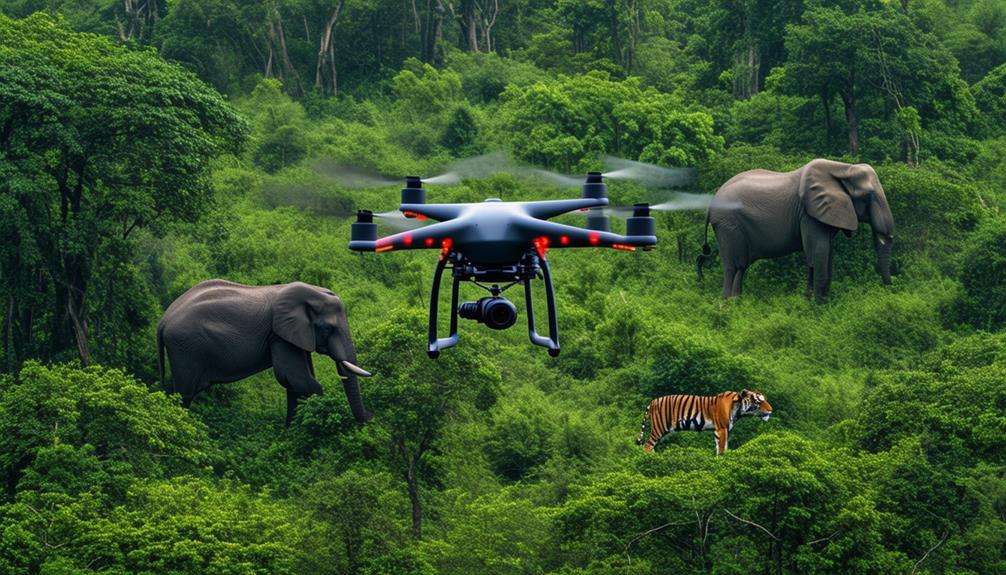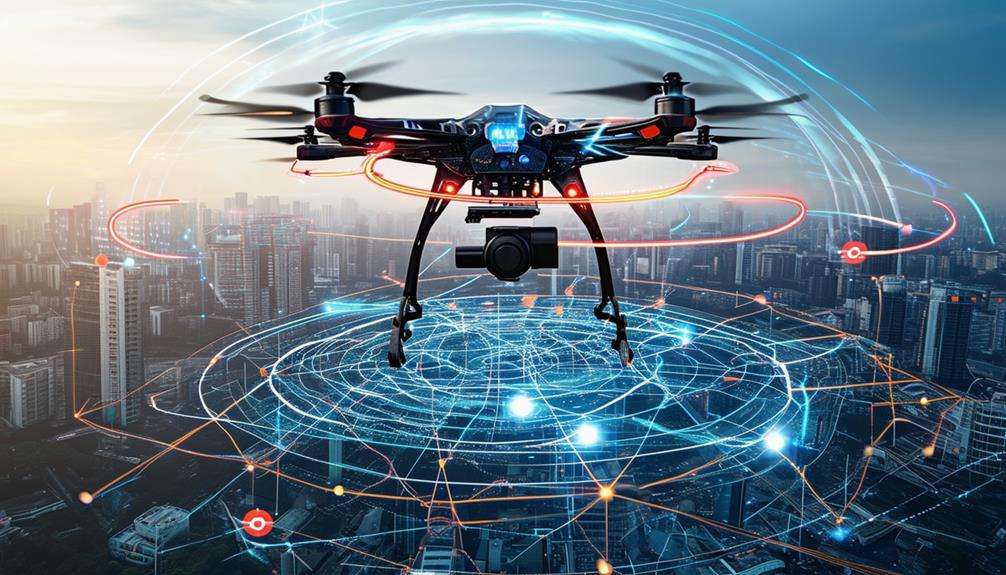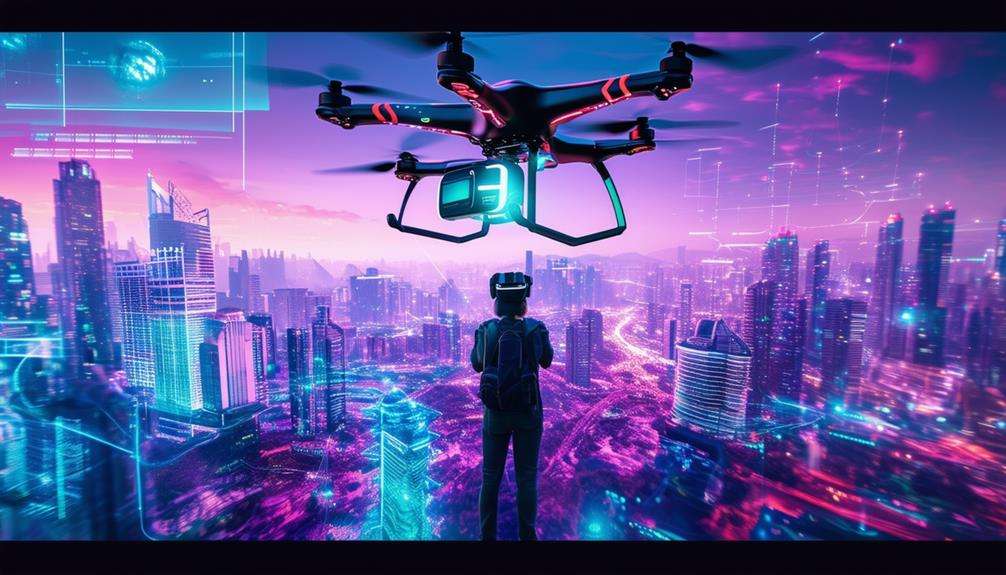Drones in Mining: How UAVs Improve Safety and Efficiency in Extraction
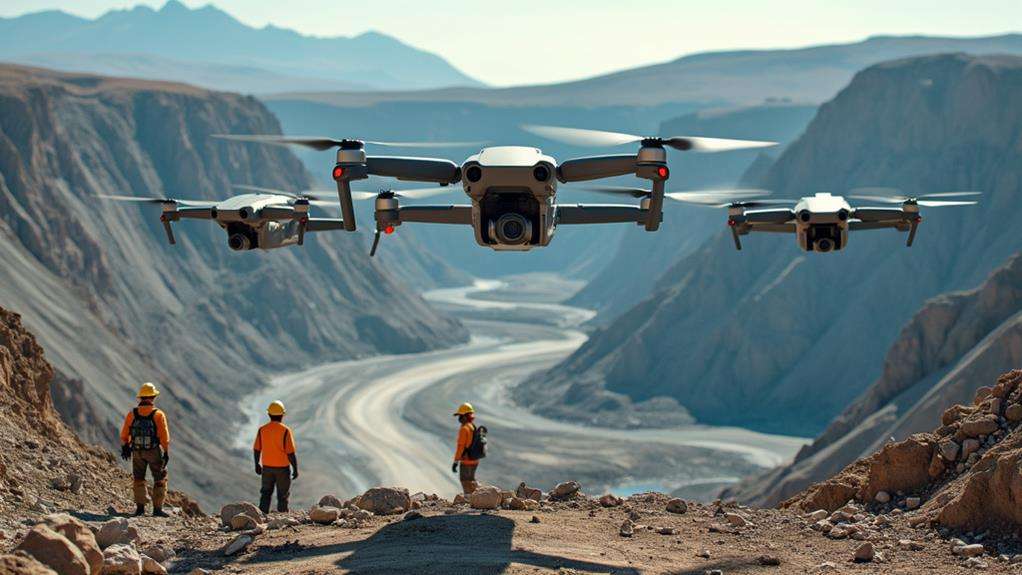
Imagine managing a mining operation where safety and efficiency are constant concerns. Unmanned Aerial Vehicles (UAVs), commonly known as drones, are revolutionizing the industry by minimizing human exposure to hazardous environments and optimizing essential tasks. Equipped with advanced sensors and high-resolution cameras, drones can perform detailed surveys and real-time monitoring much more effectively than traditional methods. Additionally, UAVs contribute to environmental sustainability and proactive risk management. Interested in how these technologies can transform your mining practices?
The Evolution of Mining
Throughout history, mining has been pivotal to human progress, beginning with the ancient discovery of metals like copper, gold, and iron. Early mining methods were manual and labor-intensive, posing significant safety risks due to the hazardous environments miners faced. As techniques evolved, the introduction of explosives, drilling machines, and heavy machinery drastically improved operational efficiency. However, these traditional methods still carried inherent dangers for workers.
Now, advanced technologies like drones, or UAVs (Unmanned Aerial Vehicles), are revolutionizing mining. Drones enhance safety by reducing the need for human presence in perilous areas. They can access hazardous environments that would otherwise pose significant risks to miners. Additionally, drones facilitate precise data collection, providing detailed aerial surveys and real-time monitoring, which traditional methods can't match.
These UAVs significantly improve operational efficiency. By offering comprehensive overviews of mining sites, they streamline extraction processes and optimize resource management. This technological evolution not only minimizes expenses but also elevates safety standards, crucial in an industry generating nearly $1 trillion in revenue. Embracing drones and other advanced technologies marks a transformative shift in mining, making operations safer and more efficient than ever before.
UAVs in Mining Operations
Incorporating UAVs into mining operations significantly enhances both safety and efficiency. For instance, drones like the Flyability Elios 3 facilitate safe inspections in hazardous environments. Additionally, UAVs equipped with advanced sensors optimize data collection, generating detailed 3D models and high-resolution imagery. This technology accelerates surveying processes, reduces costs, and minimizes the need for manual labor, thereby improving overall operational productivity.
Enhanced Safety Inspections
Unmanned Aerial Vehicles (UAVs), commonly known as drones, have revolutionized safety inspections within mining operations by offering unparalleled access to hazardous areas. By deploying drones, the need for workers to enter dangerous environments is significantly minimized, thereby reducing their exposure to potential hazards. Equipped with high-resolution cameras, these UAVs capture detailed images that help identify risks and areas of concern.
Real-time monitoring of mine stability through drones enables proactive issue resolution, preventing minor problems from escalating into serious incidents. Additionally, drones are equipped with thermal imaging and specialized sensors that can detect equipment malfunctions or leaks. This technology facilitates timely maintenance, enhancing both safety and operational efficiency.
The use of drones also significantly speeds up safety inspection tasks, completing them in hours rather than days or weeks, which saves valuable time and resources.
| Benefit | Description |
|---|---|
| High-Resolution Imaging | Captures detailed visuals to identify potential hazards |
| Real-Time Monitoring | Monitors mine stability and operational conditions continuously |
| Thermal Imaging & Sensors | Detects equipment malfunctions and leaks for timely maintenance |
| Compliance | Ensures adherence to safety regulations, preventing environmental hazards |
Continuous drone monitoring of stockpiles and tailing dams helps maintain compliance with safety regulations and reduces the risk of catastrophic failures. This proactive and efficient approach contributes to a safer and more effective mining operation.
Efficient Data Collection
The transformative impact of UAVs on data collection in mining operations is undeniable. Utilizing advanced imaging and LiDAR technology, drones can capture high-resolution 2D and 3D mapping data far more efficiently than traditional methods. They can achieve up to 10 times the efficiency, significantly reducing both time and operational costs.
Deploying autonomous UAVs allows for the survey of hard-to-reach areas in mines, generating detailed 3D point cloud maps. These maps enable accurate stockpile measurements and inventory control, drastically reducing the need for human labor. The real-time monitoring capabilities of drones facilitate continuous data analysis, allowing for proactive tracking of material availability and optimization of resource management.
Drones can complete data collection tasks in hours that would take days or even weeks manually, greatly improving operational efficiency and expediting decision-making processes. Integrating UAVs into mining operations can lead to potential savings of up to 90% in operational costs compared to using manned aircraft for similar tasks. Additionally, drones enhance safety by minimizing human intervention in hazardous areas.
Safety Inspections and Risk Assessment
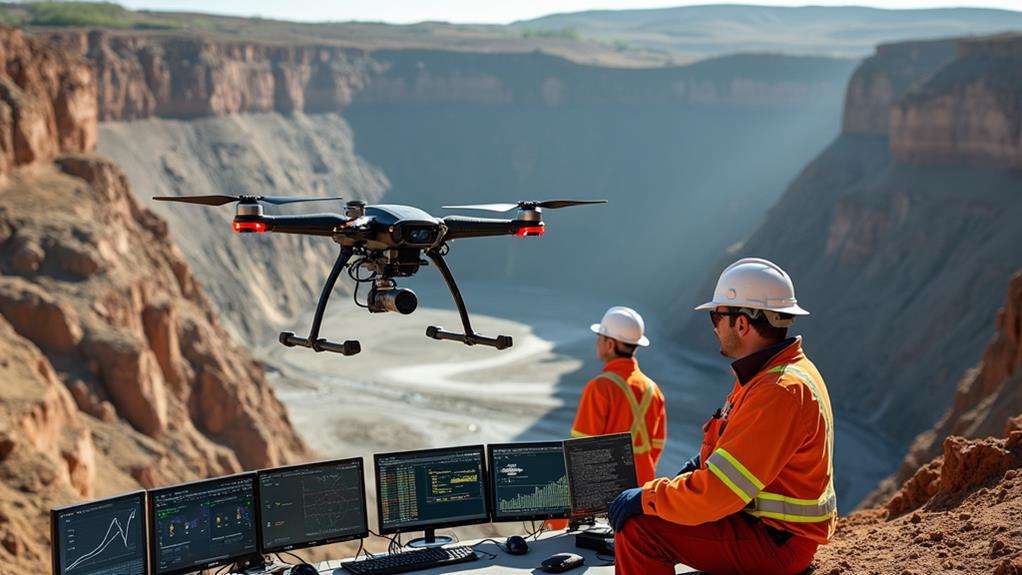
The use of drones has revolutionized safety inspections and risk assessments in mining. Drones can access hazardous areas that are too dangerous for human entry, enabling real-time monitoring of mine stability and conditions. Equipped with high-resolution cameras and thermal imaging sensors, drones capture detailed images that help identify potential hazards like structural weaknesses or leaks. This facilitates timely maintenance and effective risk mitigation.
Drones continuously monitor stockpiles and infrastructure, making it easier to detect stability issues and abnormal conditions that could lead to accidents. Their ability to generate 3D models of mining sites enhances situational awareness by providing accurate topographical data to identify geological hazards. This comprehensive approach to risk assessment significantly improves safety outcomes, ensuring a safer working environment.
Surveying and Mapping
Modern mining surveying and mapping have achieved unprecedented efficiency and accuracy by leveraging advanced technologies. Drones equipped with high-resolution cameras and LiDAR technology capture 2D and 3D mapping data up to five times faster and at costs up to ten times lower than traditional methods. This results in significant time and cost savings while enhancing survey precision.
Utilizing UAVs for stockpile management revolutionizes the process by providing accurate volumetric measurements, minimizing errors, and ensuring precise tracking of excavated material and backfill requirements. This level of accuracy significantly improves operational planning and decision-making.
Drones can generate detailed 3D models, offering comprehensive site visualizations that are crucial for planning and safety. Specialized drone software processes data rapidly, producing approximately 1.3 million points per second for dense, detailed mapping outputs. This enables quick, informed decision-making.
Additionally, drones can access hazardous or difficult terrains, allowing for safe and efficient data collection in areas that are unsafe or unreachable by traditional methods. This not only enhances safety but also ensures comprehensive mapping of the entire mining site.
Environmental Monitoring
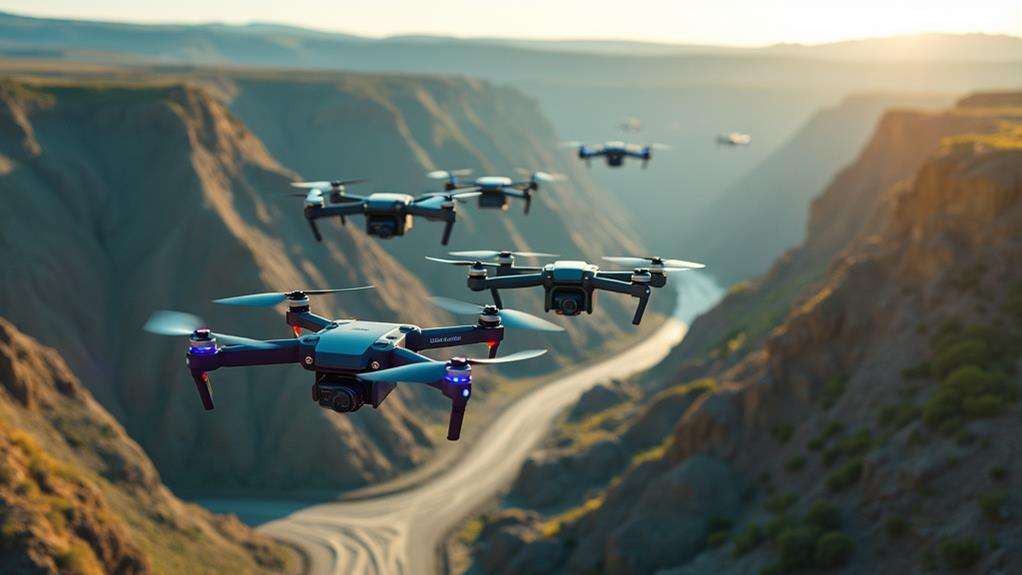
In the field of environmental monitoring, drones are instrumental in assessing air and water quality in mining areas. They help detect pollutants, ensuring regulatory compliance. Equipped with advanced sensors, drones can also identify soil erosion, provide updates on landscape changes, and assist in restoration efforts. These capabilities enable the maintenance of a healthier environment surrounding mining operations.
Air and Water Quality
Using drones for air and water quality monitoring in mining operations is transformative. They offer a versatile and efficient way to track environmental conditions, ensuring compliance with regulations and safeguarding the ecosystem.
Here's why drones are indispensable for air and water quality monitoring:
- Real-time data collection: Drones provide immediate insights, enabling swift action to prevent environmental harm.
- Regulatory compliance: Real-time data ensures that mining operations meet regulatory standards.
- Comprehensive coverage: Drones can quickly survey large areas, offering thorough assessments that traditional methods may overlook.
- Sustainable practices: Enhanced monitoring reduces ecological impacts, supporting responsible mining activities.
- Risk management: Drones can analyze water quality parameters such as pH and contaminant levels, helping to mitigate risks associated with tailing dams and runoff.
Integrating drones into mining operations improves air and water quality monitoring, fostering more sustainable practices. By leveraging drone technology, you enhance regulatory compliance and protect the environment from the negative impacts of resource extraction.
Soil Erosion Detection
Drones equipped with high-resolution cameras and sensors provide a significant advantage for monitoring soil erosion in mining operations. They capture detailed imagery that delivers real-time data on erosion-affected areas, which is crucial for environmental monitoring. This capability enables the assessment of erosion rates and the identification of critical zones needing immediate attention.
Utilizing drones, or UAVs, allows for the rapid coverage of large areas, detecting soil erosion patterns that traditional ground surveys may overlook. This leads to more efficient resource management within mining operations. The detailed imagery collected supports data-driven decisions, ensuring compliance with environmental regulations regarding soil preservation.
Future Trends in Mining Drones
The future of mining drones is bright as advancements in AI and machine learning continue to enhance drone systems, significantly improving data analysis capabilities. These innovations will enable drones in the mining sector to more accurately identify geological features and optimize decision-making, leading to more efficient mine operations. With autonomous navigation and advanced sensors, drones will survey and monitor mining environments with unprecedented efficiency.
Key trends in mining drones include:
- Specialized LiDAR and Advanced Sensors: Enhanced imaging and sensor technology will deliver precise, real-time data, improving resource management and reducing operational costs.
- Autonomous Navigation: Drones capable of navigating challenging terrains without human intervention will ensure continuous and comprehensive monitoring.
- Sustainable Resource Identification: Advanced data analysis will facilitate responsible resource detection and management, addressing environmental challenges.
- Cost Reduction and Accessibility: Lowering costs and increasing access to drone technology will enable small to mid-sized mining firms to adopt these innovations.
- Mine Restoration Assistance: Drones will support sustainable practices by aiding in the restoration of mined areas, promoting environmental stewardship.
Embracing these trends will enhance worker safety and foster a more sustainable and efficient approach to mining.

